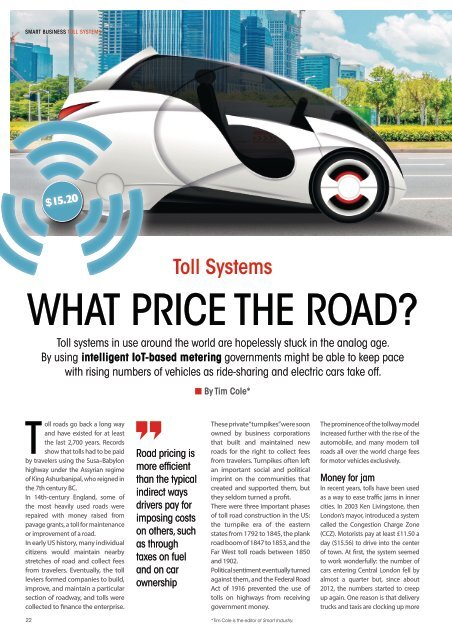Smart Industry 1/2018
Smart Industry 1/2018 - The IoT Business Magazine - powered by Avnet Silica
Smart Industry 1/2018 - The IoT Business Magazine - powered by Avnet Silica
Create successful ePaper yourself
Turn your PDF publications into a flip-book with our unique Google optimized e-Paper software.
<strong>Smart</strong> Business Toll Systems<br />
$ 15. 20<br />
Toll Systems<br />
What Price the Road?<br />
Toll systems in use around the world are hopelessly stuck in the analog age.<br />
By using intelligent IoT-based metering governments might be able to keep pace<br />
with rising numbers of vehicles as ride-sharing and electric cars take off.<br />
■ By Tim Cole*<br />
Toll roads go back a long way<br />
and have existed for at least<br />
the last 2,700 years. Records<br />
show that tolls had to be paid<br />
by travelers using the Susa–Babylon<br />
highway under the Assyrian regime<br />
of King Ashurbanipal, who reigned in<br />
the 7th century BC.<br />
In 14th-century England, some of<br />
the most heavily used roads were<br />
repaired with money raised from<br />
pavage grants, a toll for maintenance<br />
or improvement of a road.<br />
In early US history, many individual<br />
citizens would maintain nearby<br />
stretches of road and collect fees<br />
from travelers. Eventually, the toll<br />
leviers formed companies to build,<br />
improve, and maintain a particular<br />
section of roadway, and tolls were<br />
collected to finance the enterprise.<br />
Road pricing is<br />
more efficient<br />
than the typical<br />
indirect ways<br />
drivers pay for<br />
imposing costs<br />
on others, such<br />
as through<br />
taxes on fuel<br />
and on car<br />
ownership<br />
These private “turnpikes” were soon<br />
owned by business corporations<br />
that built and maintained new<br />
roads for the right to collect fees<br />
from travelers. Turnpikes often left<br />
an important social and political<br />
imprint on the communities that<br />
created and supported them, but<br />
they seldom turned a profit.<br />
There were three important phases<br />
of toll road construction in the US:<br />
the turnpike era of the eastern<br />
states from 1792 to 1845, the plank<br />
road boom of 1847 to 1853, and the<br />
Far West toll roads between 1850<br />
and 1902.<br />
Political sentiment eventually turned<br />
against them, and the Federal Road<br />
Act of 1916 prevented the use of<br />
tolls on highways from receiving<br />
government money.<br />
The prominence of the tollway model<br />
increased further with the rise of the<br />
automobile, and many modern toll<br />
roads all over the world charge fees<br />
for motor vehicles exclusively.<br />
Money for jam<br />
In recent years, tolls have been used<br />
as a way to ease traffic jams in inner<br />
cities. In 2003 Ken Livingstone, then<br />
London’s mayor, introduced a system<br />
called the Congestion Charge Zone<br />
(CCZ). Motorists pay at least £11.50 a<br />
day ($15.56) to drive into the center<br />
of town. At first, the system seemed<br />
to work wonderfully: the number of<br />
cars entering Central London fell by<br />
almost a quarter but, since about<br />
2012, the numbers started to creep<br />
up again. One reason is that delivery<br />
trucks and taxis are clocking up more<br />
22<br />
*Tim Cole is the editor of <strong>Smart</strong> <strong>Industry</strong>.
















